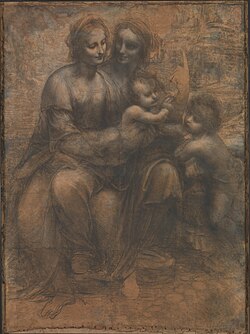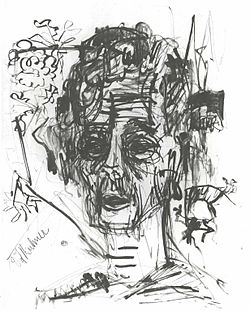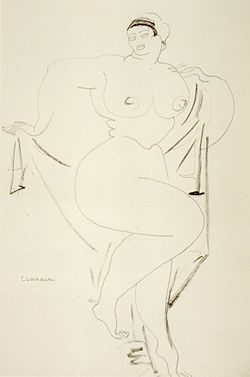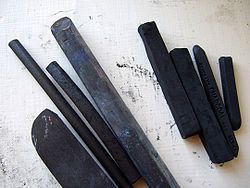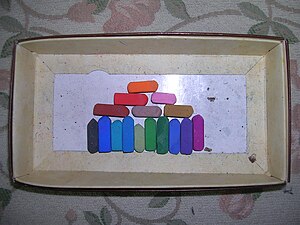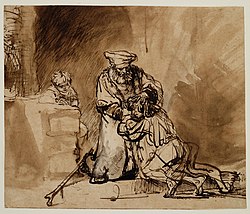Drawing
| Art Appreciation and Techniques (#ART100) | |
|---|---|
| Artistic media: Two-dimensional art | Overview | Introduction | Drawing | Painting | Printmaking | Collage | Summary |
Drawing media is organized into two types: dry and wet.
Dry media
Dry Media includes charcoal, graphite, chalks and pastels. Each of these mediums gives the artist a wide range of mark making capabilities and effects, from thin lines to large areas of color and tone. The artist manipulates the medium to achieve desired effects by exerting different pressure on the medium against the drawing’s surface, or by erasure or blotting. The process of drawing instantly transfers a character to the image. From energetic to subtle, these qualities are apparent in the simplest works: the immediate and unalloyed spirit of the artist’s idea. You can see this in the self-portraits of two German artists; Kathe Kollwitz and Ernst Ludwig Kirchner. Wounded during the first world war, Kirchner's Self-Portrait Under the Influence of Morphine from about 1916 presents us with a nightmarish vision of himself wrapped in the fog of opiate drugs. His hollow eyes and the graphic dysfunction of his marks attest to the power of his drawing.
Charcoal drawings range in tones from light gray to rich, velvety blacks. A charcoal drawing by American artist Georgia O’Keeffe shows these tonal ranges.
More recent developments in dry media are oil pastels, pigment mixed with an organic oil binder that deliver a heavier mark and lend themselves to more graphic and vibrant results. The drawings of Beverly Buchanan reflect this. Her work celebrates rural life of the southern United States centered in the forms of old houses and shacks. The buildings stir memories and provide a sense of place, and are usually surrounded by people, flowers and bright landscapes. She also creates sculptures of the shacks, giving them an identity beyond their physical presence.
Wet media
Felt tip pens are considered a form of wet media. The ink is saturated into felt strips inside the pen then released onto the paper or other support through the tip. The ink quickly dries, leaving a permanent mark. The colored marker drawings of Donnabelle Casis have a flowing, organic character to them. The abstract quality of the subject matter infers body parts and viscera.
Other liquids can be added to drawing media to enhance effects – or create new ones. Artist Jim Dine has splashed soda onto charcoal drawings to make the surface bubble with effervescence. The result is a visual texture unlike anything he could create with charcoal alone, although his work is known for its strong manipulation. Dine’s drawings often use both dry and liquid media. His subject matter includes animals, plants, figures and tools, many times crowded together in dense, darkly romantic images.
Traditional Chinese painting uses water-based inks and pigments. In fact, it is one of the oldest continuous artistic traditions in the world. Painted on supports of paper or silk, the subject matter includes landscapes, animals, figures and calligraphy, an art form that uses letters and script in fluid, lyrical gestures. Two examples of traditional Chinese painting are seen below. On the left, a wall scroll painted by Ma Lin in 1246, demonstrates how adept the artist is in using ink in an expressive form to denote figures, robes and landscape elements, especially the strong, gnarled forms of the pine trees. There is sensitivity and boldness in the work. On the right is the opening detail of a copy of Preface to the Poems Composed at the Orchid Pavilion made before the 13th century. Using ink and brush, the artist makes language into art through the sure, gestural strokes and marks of the characters.
Drawing is a foundation for other two and three-dimensional works of art, even being incorporated with digital media that expands the idea of its formal expression. The art of Matthew Ritchie starts with small abstract drawings. He digitally scans and projects them to large scales, taking up entire walls. Ritchie also uses the scans to produce large, thin three-dimensional templates to create sculptures out of the original drawings.
